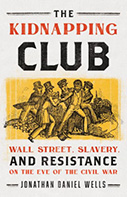The Kidnapping Club: Wall Street, Slavery, And Resistance On The Eve Of The Civil War

Author: Jonathan Daniel Wells
Publisher: New York: Bold Type Face (Hachette), 2020. 368p.
Reviewer: Alan Singer | February 2021
Jonathan Daniel Wells is a professor of history and Afroamerican and African Studies at the University of Michigan. The broad sweep of The Kidnapping Club: Wall Street, Slavery, and Resistance on the Eve of the Civil War is an important and generally well-written contribution to the history of ante-bellum New York. Wells establishes the complicity of New York bankers, merchants and Democratic Party politicians with the Slavocracy of the South and implicates Moses Taylor, founder of the predecessor bank that is today’s Citibank, and Mayor and Congressional Representative Fernando Wood for their ties to Southern and Caribbean slaveholders. The stories of children being kidnapped, including a seven-year-old boy who was grabbed while he was attending school, and official indifference to or complicity with these children’s plight, are graphically recounted and should be especially distressing to readers.
The book opens with a focus on a group of seventeen enslaved Africans who escaped from bondage in Virginia; on Tobias Boudinot and Daniel D. Nash, notorious New York City police officers who terrorized suspected runaways and Black New Yorkers; on city official Richard Riker who presided over judicial proceedings that were a mockery of justice; and on African American resistance. In some ways, the book serves as an additional biography of African American civil rights activist and newspaper publisher David Ruggles. This is both a strength and a drawback. Ruggles’ activities provide an integrating narrative for the first half of the book, but because of his battles with other abolitionists, both Black and white, and his “go-it-alone approach,” it minimizes their roles in the anti-slavery movement — at least until Ruggles leaves New York in 1842.
As New York City rapidly grew in the first half of the 19th century, it was an important stop on the Underground Railroad. The city was large enough so escapees from slavery could blend in and be housed and protected by abolitionist networks while they prepared to move north along the Hudson River towards the Erie Canal and Canada, or by boat to New England. There also was work on the docks and in construction, which allowed freedom-seekers to support themselves and accumulate some money in reserve. Equally important, there were Black and white abolitionists in the New York Committee of Vigilance who would rally to assist people seized off the street and threatened with enslavement.
A third of the way through the book, Wells abruptly changes focus from the Kidnapping Club to New York’s role in the illegal trans-Atlantic slave trade. This was a good decision, and the chapters, “New York, a Port in the Slave Trade,” “New York and the Transatlantic Slaves Trade, and “The Portuguese Company,” are well researched; but this also suggests that the title of the book, The Kidnapping Club, was chosen for dramatic effect, rather than as an accurate description of the contents. The final two chapters are about New York’s role in the “secession crisis” when Mayor Fernando Wood and much of the merchant community initially sympathized with the South and the Copperhead Democratic press attack on President Lincoln and the effort to preserve the United States. These chapters are also well-researched and well-written.
The book provides a comprehensive account documenting New York City’s complicity with the trans-Atlantic slave trade and the marketing of slave produced commodities. Wells quotes New York Governor William Marcy’s 1836 State of the State Address wherein Marcy praised the “bonds of amity and concord which unite us to the people of the South” and condemned the anti-slavery movement as “seditious, incendiary and wicked” (78). Tradesmen in the port city benefited from outfitting ships headed for Africa where captives were loaded aboard for shipment to Cuba. Local insurance companies insured both voyages and the lives of enslaved Africans. Politicians, law enforcement, and the courts ignored what was taken place even when ships brought enslaved Africans into what was supposed to be a free city (83-96). Because slave trading by a United States citizen was a capital offense, ship ownership was usually held, at least on paper, by foreign nationals, and ship captains were not American. Even when arrests were made, politically appointed judges interpreted the law to juries in ways that ensured acquittals, or in the unlikely event of a guilty verdict, issued light sentences (230-242).
Wells has an extended section on Black villages in the independent city of Brooklyn that provided safe havens across the East River when racial tension escalated in New York City. In the Brooklyn section, Wells describes an incident in 1838 in which Ruggles was able to free a woman named Charity who was kept illegally enslaved by a family that had relocated from Georgia (147-150). When the slaveholding Dodge family moved from Savannah to Brooklyn, they brought three enslaved Africans with them as household servants, and kept them enslaved in their Brooklyn home for four years. When Ruggles learned of the situation, he traveled to Brooklyn and confronted Mrs. Dodge. She claimed the three were household servants, not slaves, and were not being held against their will. Under Ruggles prodding, Charity confronted Mrs. Dodge, who finally conceded that Charity and the other two were unpaid slave labor. Charity left the home with Ruggles, however the other two remained and were probably returned to the South. At least one local newspaper, the New York Gazette, castigated Ruggles for interfering with the private affairs of a prominent family, and blamed him for Charity’s subsequent fall into poverty.
Wells ends the book with a brief discussion of “The Hidden Past and Reparations Due.” He sees his book as part of the effort to expose past injustices that continue to fester and infect American society, and as support for the Black Lives Matter movement and the call for reparations. In the epilogue, the author compares the Kidnapping Club and racist police practices in the 19th century with the rogue police actions today that have led to the deaths of numbers of African Americans.
While the broad sweep of the book, as I noted above, is very good, there are problems that are troubling to me as a historian. The 1834 riots in New York City, what Wells labels anti-Black riots, targeted abolitionists, not just the city’s African American community (60). The Tappan brothers had to mobilize armed supporters to defend the office of their importing business and their homes.
The first question I had as I read this book was whether the slavecatchers called themselves the Kidnapping Club, or if it was a label assigned to them by Wells. From my own work, I knew that “blackbird” bounty hunters patrolled the streets of New York City and Brooklyn hoping to grab self-emancipated freedom-seekers bound north, and that they were willing to sweep up any Black child or adult they thought they could whisk out of the city. David Ruggles wrote about the kidnapping and shipping off into slavery of George Jones in an 1836 article in The Liberator, and an attempt to kidnap him in a letter to the New York American. Harriet Jacobs in Incidents in the Life of a Slave Girl (originally published in 1861) warned, “New York was a city of kidnappers.” I had not previously read where either Ruggles or Jacobs referred to an actual Kidnappers Club. Wells credits Ruggles with coining the phrase and acknowledges, “it was not an organized party or ring, or even a group of men who socialized together” (9). The book’s references about this are only to secondary sources, and not to anything written by Ruggles or in the literature of the New York Vigilance Committee that he helped to found.
As a historian, I compulsively check a footnote when I read something I did not know before, or that I think is an error. On page 3, Wells writes that Trinity Church was “the place where George Washington and Alexander Hamilton had worshipped when the federal government sat in New York.” The footnote cites Gotham by Edward Burrows and Mike Wallace (pg. 109 and 176-177), but those pages do not mention Washington or Hamilton attending Trinity Church. According to the church website (https://www.trinitywallstreet.org/about/history), the first Trinity Church building was destroyed by fire in 1776, and while in New York Washington usually prayed at St. Paul’s Chapel. The second Trinity Church building was completed in 1790, and Washington did attend services there for a short time until the seat of government moved to Philadelphia. The original St. Paul’s Chapel building is still in lower Manhattan near present day City Hall, and until recently Washington’s pew was on display there.
While describing the “massive contradictions” present in the city, Wells writes that Moses Taylor “would become one of Gotham’s leading conservatives by constantly reminding his fellow New Yorkers that their multiroom mansions, sprawling gardens, and armies of domestic servants were made possible by the cotton trade” (56). Taylor, however, is not actually quoted, and there is no citation to support this. In my own research, I found Taylor was much more deeply involved in the Cuban sugar trade in the 1830s than he was in the Southern cotton trade.
The story of David Ruggles’ confrontation with Mrs. Dodge is largely based on accounts Ruggles published in his newspaper Mirror of Liberty in August 1838 and January 1839. Wells writes that “The New York Times denounced Ruggles, promising its readers that the paper would keep them informed of Charity’s plight” (151). The newspaper we know as The New York Times did not begin publishing until 1851. This may have been a reference to a different newspaper, but that is not explained in the text.
The Kidnapping Club: Wall Street, Slavery, and Resistance on the Eve of the Civil War is an important and engaging work of history. But better fact checking and endnotes by the author would have addressed these flaws.
Alan Singer, Professor, Hofstra University


